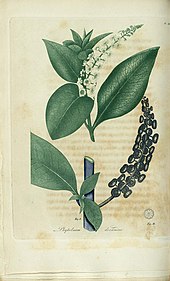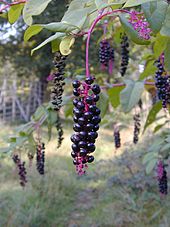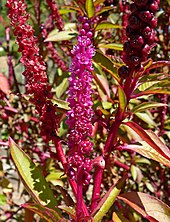Pokeweed
| Pokeweed | ||||||||||||
|---|---|---|---|---|---|---|---|---|---|---|---|---|

American pokeweed ( Phytolacca americana ) with hanging pods. |
||||||||||||
| Systematics | ||||||||||||
|
||||||||||||
| Scientific name | ||||||||||||
| Phytolacca | ||||||||||||
| L. |
The pokeweed ( Phytolacca ) are a genus of plants within the pokeweed family (Phytolaccaceae). The German common name pokeweed comes from the Persian word قرمز qermez for red .
description






Appearance and leaves
In Phytolacca TYPES There are mostly perennial herbaceous plants rarely, shrubs or trees that reach stature heights of approximately 1 to 2 meters. The mostly upright, rarely climbing, pencil-shaped, furrowed or angular stem is sometimes reddish. In addition to young stems, the inflorescences are sometimes hairy, otherwise the parts of the plant are hairless. The roots are usually thick and fleshy. The mostly stalked leaves have a simple leaf blade.
Inflorescences and flowers
Five to a hundred stalked or sessile flowers stand together in terminal or leaves opposite, racemose , spiked or zymous inflorescences .
The mostly hermaphrodite flowers are radial symmetry and five-fold. There are only five to sometimes eight bracts available; they are mostly greenish-white during the flowering period and enlarge and become red as the fruit develops. In one or two circles there are usually ten (6 to 33) stamens ; they are free or fused at their base and may or may not protrude from the flower envelope. There are 5 to 16, rarely up to 30 carpels present; they are free or overgrown. When the carpels are fused, the ovary is almost spherical. There are as many free, awl-shaped styles as carpels.
Fruits and seeds
The fruits are usually fleshy, flattened berries , usually with six to twelve (rarely up to 30) seeds, which have up to as many lobes as carpels are involved; or solitary, achena-like fruits are formed. The black, shiny seeds are kidney-shaped to compressed with a hard, fragile, hairless testa .
Systematics and distribution
The distribution of the genus Phytolacca is almost cosmopolitan, but most of the species are native to South America , and overall there are more species in the New World than in the Old World; only a few species have their natural home in Africa or Eurasia . Some species are invasive plants around the world . Pokeweed species ( Phytolacca ) occur predominantly in tropical to subtropical areas and in wine-growing areas. Feral species can be found all over the world.
The genus Phytolacca was established by Carl von Linné . The botanical genus name Phytolacca comes partly from the Greek word φυτόν (phyton) for “plant” and partly from the Latin lacca for “lacquer” and refers to the appearance of the berries. A synonym for Phytolacca L. is Pircunia Bertero ex Ruschenb.
The identification of the species is difficult, this led to many synonyms. About 25 to 35 Phytolacca species are known, here is a selection:
- Phytolacca abyssinica Hoffm. : Home is Africa.
- Edible pokeweed , pokeweed or Asian pokeweed ( Phytolacca acinosa Roxb. , Syn . : Phytolacca esculenta Van Houtte , Phytolacca pekinensis Hance ): It is originally widespread in China , Bhutan , India , Japan , Korea , Myanmar , Sikkim and Vietnam . In South and Central America it is a neophyte . It is used as a medicinal plant.
- American pokeweed ( Phytolacca americana L. , Syn: Phytolacca decandra L. ): It is distributed from eastern Canada and the United States to Mexico and occurs in Bolivia .
- Phytolacca bogotensis Kunth : It iswidespreadin South America from Colombia , Bolivia, Brazil , Paraguay , Ecuador to Peru and Argentina .
- Phytolacca chilensis (Miers ex Moq.) H. Walter : It is distributed in the southern part of South America .
- Phytolacca clavigera W.W.Sm. : Home is Southeast Asia .
- Dioecious pokeweed or (in South America) Ombú ( Phytolacca dioica L. ): This tree with stature heights of up to 25 meters is widespread in South America from Bolivia, Ecuador, Paraguay, Uruguay , Brazil, to Argentina and Peru.
- Phytolacca dodecandra L'Hér. : It occurs in tropical and southern Africa and in Madagascar . For Ethiopia see Endod .
- Phytolacca heptandra Retz.
- Phytolacca heteropetala H.Walter : The home is Mexico . It was introduced in California and is a neophyte in Portugal.
- Phytolacca icosandra L. (Syn: Phytolacca octandra L. ): It iswidespreadin the Neotropics from Mexico through Central America and on the Caribbean islands to Peru.
- Phytolacca japonica Makino : It is common in Japan , Taiwan and in the Chinese provinces of Anhui , Fujian , Guangdong , Hunan , Jiangxi , Shandong and Zhejiang .
- Phytolacca latbenia (Moq.) H. Walter
- Phytolacca meziana H.Walter : It occurs in Central America .
- Phytolacca polyandra Batalin : It is the only species that is only native to China: It thrives at altitudes of 1100 to 3000 meters in Gansu , Guangxi , Guizhou , Sichuan and Yunnan .
- Phytolacca rivinoides Kunth & CDBouché : It is widespread from Mexico via Central America and on the Caribbean islands to South America.
- Phytolacca rugosa A.Braun & CDBouché : It is distributed from Mexico to Central America to Bolivia, Colombia, Peru and Venezuela.
- Phytolacca sanguinea H.Walter : It is distributed in Colombia, Ecuador, Peru and Venezuela.
- Phytolacca tetramera Hauman : It is common in the southern part of South America .
- Phytolacca thyrsiflora Fenzl ex JASchmidt : It is distributed in Brazil , Colombia, the Guyanas , Peru, Venezuela, in the southern part of South America and on the Caribbean islands.
- Phytolacca weberbaueri H.Walter : It occurs in Peru.
Invasive species
None of the species is native to Central Europe, but rather they belong to the neophytes in Central Europe . In 2002 it was not yet known whether there was a harmful effect on the native flora . The geoecologist Constanze Buhk from Landau warns, “ According to recent studies, even beech trees would have difficulties on the soil that Phytolacca spec. is burdened to be able to germinate at all. That makes them so competitive and therefore dangerous, because they can really destroy everything ”. "In many gardens in southern Germany you can now find her as a 'permanent guest'."
use
Due to the triterpene saponine ( phytolaccagenin ) and lectins, they are slightly to poisonous for mammals . The concentration of the toxic ingredients decreases as follows: root, leaf, stem, unripe fruit, ripe fruit.
Because of the toxins, food-grade pokeweed products must be treated or prepared accordingly. The berries contain dark red to black pigment, betacyane (Phytolaccarot) is similar to that of beetroot . They were previously used to color red wine, liqueurs and pastries, but because of their strong laxative effect, this was banned. It was also used to dye wicker , wool, silk , leather and make-up. The Indian pokeweed and Phytolacca dioica were also used for dyeing. To dye wool fuchsin red, the wool, which has been pre-stained with alum or tartar , is dipped in an extract of the dye acidified with vinegar .
The leaves are elliptical in shape. In America, young pokeweed leaves are prepared in a similar way to spinach. Pokeweed is also known as polk salad in the USA and used to play an important role in Louisiana's cuisine. Tony Joe White wrote the song Polk Salad Annie about it , which was also covered by Elvis Presley .
The sprouts have an asparagus-like taste.
In 1989, Aklilu Lemma and Legesse Wolde-Yohannes were awarded the Right Livelihood for their in-depth research into the properties of the endodic plant ( Phytolacca dodecandra ) as an inexpensive prophylactic against schistosomiasis and for their struggle to overcome the bias of Western medicine against Third World research Award .
swell
- Mark A. Nienaber, John W. Thieret: Phytolaccaceae : Phytolacca , p. 3 - same text online as the printed work , In: Flora of North America Editorial Committee (ed.): Flora of North America North of Mexico , Volume 4 - Magnoliophyta: Caryophyllidae, part 1 , Oxford University Press, New York and Oxford, 2003, ISBN 0-19-517389-9 . (Sections Description and Systematics)
- Dequan Lu, Kai Larsen: Phytolaccaceae : Phytolacca , p. 435 - the same text online as the printed work , In: Wu Zheng-yi, Peter H. Raven (Ed.): Flora of China , Volume 9 - Pittosporaceae through Connaraceae , Science Press and Missouri Botanical Garden Press, Beijing and St. Louis, 2003, ISBN 1-930723-14-8 . (Sections Description and Systematics)
- GJ Harden: Phytolaccaceae in the Flora of New South Wales : Phytolacca - largely taken from the printed Flora of New South Wales and uploaded online by The Royal Botanic Gardens and Domain Trust. (Section description)
Individual evidence
- ^ Phytolacca at Tropicos.org. Missouri Botanical Garden, St. Louis, accessed October 23, 2018.
- ↑ a b c d e f g h i Phytolacca in the Germplasm Resources Information Network (GRIN), USDA , ARS , National Genetic Resources Program. National Germplasm Resources Laboratory, Beltsville, Maryland.
- ↑ a b c d Dequan Lu, Kai Larsen: Phytolaccaceae : Phytolacca , p. 435 - online with the same text as the printed work , In: Wu Zheng-yi, Peter H. Raven (ed.): Flora of China , Volume 9 - Pittosporaceae through Connaraceae , Science Press and Missouri Botanical Garden Press, Beijing and St. Louis, 2003, ISBN 1-930723-14-8 .
- ↑ a b c d e f g h i j k l m Phytolacca at Tropicos.org. In: 83 . Missouri Botanical Garden, St. Louis
- ^ I. Kowarik, U. Starfinger (Ed.): Biologische Invasionen. Challenge to action? In: NEOBIOTA , 1, 2002, pp. 5-24
- ↑ Volker Mrasek : Next invasion is rolling, American pokeweed is spreading massively in southwest German forests. Deutschlandfunk - broadcast on October 11, 2013
- ↑ Bruno Vonarburg: Homeotany: Colorful autumn. Volume 3, 2nd edition, Haug, 2005, ISBN 978-3-8304-7227-8 , p. 61.
- ↑ Wolfgang Steglich, Burkhard Fugmann, Susanne Lang-Fugmann (eds.): RÖMPP Lexikon Naturstoffe. Thieme, 1997, ISBN 3-13-749901-1 , p. 494.
- ^ Gerhard Eisenbrand, Peter Schreier: RÖMPP Lexikon Lebensmittelchemie. 2nd edition, Thieme, 2006, ISBN 978-3-13-736602-7 , p. 604.
- ↑ G. Frerichs, G. Arends, H. Zörnig: Hagers Handbook of Pharmaceutical Practice. 2. Volume K-Z , 2nd edition, Springer, 1949, ISBN 978-3-642-49483-3 , p. 439.
- ↑ Ira S. Richards, Marie Bourgeois: Principles and Practice of Toxicology in Public Health. 2nd edition, Jones & Bartlett, 2014, ISBN 978-1-4496-4526-7 , p. 76.
- ^ Bradford Angier: Field Guide to Edible Wild Plants. Stackpole Books, 1974, ISBN 0-8117-2018-7 , p. 170.
- ^ New Scientist . Nov 11, 1989, p. 21.
Web links
- Phytolacca at Plants For A Future
- Phytolacca at Tropicos.org. In: Flora of Pakistan . Missouri Botanical Garden, St. Louis
- Phytolacca at Tropicos.org. In: Peru Checklist . Missouri Botanical Garden, St. Louis
- Phytolacca at Tropicos.org. In: Flora Palestine . Missouri Botanical Garden, St. Louis
- Phytolacca at Tropicos.org. In: Flora de Nicaragua . Missouri Botanical Garden, St. Louis
- Phytolacca at Tropicos.org. In: Flora Mesoamericana . Missouri Botanical Garden, St. Louis
- Phytolacca at Tropicos.org. In: Catalog of the Vascular Plants of Madagascar . Missouri Botanical Garden, St. Louis
- Phytolacca at Tropicos.org. In: Flora of Panama (WFO) . Missouri Botanical Garden, St. Louis
- Phytolacca at Tropicos.org. In: Catalog of the Vascular Plants of Ecuador . Missouri Botanical Garden, St. Louis
- Phytolacca at Tropicos.org. In: 66 . Missouri Botanical Garden, St. Louis
- Phytolacca at Tropicos.org. In: Bolivia Checklist . Missouri Botanical Garden, St. Louis
- Phytolacca at Tropicos.org. In: IPCN Chromosome Reports . Missouri Botanical Garden, St. Louis

